Singing whales weren't the only ones we encountered during the Jocara trip.
To be upfront, it's been a relatively slow start to the season. There are certainly whales here. I've seen them every day I've been out on the water. But qualitatively, there don't seem to be as many interactive whales (i.e., ones you can spend quality time with) as normal for this time of year.
Over the past week and a half, I know there were two mother and calf pairs in the area. We saw one in the water, but were unable to get in with the other. There certainly might be more, but I haven't heard any credible reports.
Usually by now, there should be more, though there have been other years with relatively few babies early on, such as in 2007, but quite a few later in the season.
When you get right down to it, there's really no way of knowing how things will play out until the end of the season.
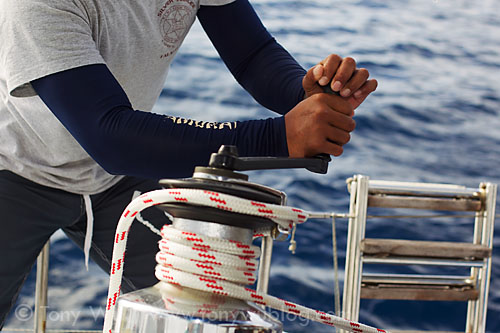
Working the ropes on Jocara
Besides the mothers and babies, there seem to be a lot of young whales here, say between one to five years of age or so, i.e., sexually immature whales. The first two singers we recorded are good examples, and we've sighted many others either playing alone, or travelling in pairs.
Other boats have reported large heat runs, and I know of encounters with at least three separate mating pairs of whales.
As I alluded to above, it's far too early in the season to generalise about how things are going, but if I can indulge in a bit of speculation…
Over the past three years, I've ID-ed over 60 calfs. Since there's no way I saw all the babies, I think it's reasonable to assume there were well over 100 calfs in this group of whales over the past three years.
This number would suggest that a significant proportion of the breeding females in this humpback whale group have had babies in the recent past. Females that have just had babies are relatively less likely to have them again right away (though I've ID-ed two moms here that had babies two years in a row in 2008 and 2009).
Not all the young would have survived, but the number of babies could help explain the seemingly high number of young whales we've seen so far. Other explanations, of course, could be that the young whales arrived earlier than the others, the older ones are busy elsewhere, or I'm just imagining things.
I've also sensed in the past that high-baby years seem to run somewhat countercyclical with seasons with a relatively high number of heat runs and mating pairs. This seems to makes sense, since females with babies are relativley less likely to be engaging in courtship/ mating (though it does happen), while females without babies are relatively more likely to do so.
So…one of the things that will be of interest to me as the season progresses is to see how the baby count goes versus the relative frequency of heat runs and mating pair encounters.
Ongo
On 6 August, the last day that we were out on the water, I made my first calf ID for the season. It was a relatively new calf, perhaps in the two- to three-week old range, and absolutely adorable.
The visibility was poor, and the mother was skittish, so I wasn't able to take any prize-winning photos, but I was able to get a good enough look to ID the baby.
Both mommy and baby are nearly all black, with the baby having small white patches just behind both eyes. The mother has an easily recognisable pattern on the ventral surface of her fluke…mostly black, with white areas toward the the upper corners on both sides. In short…it's easy to ID this pair again.
I decided to name the baby Ongo, in honour of my close friend and mentor here who passed away just days after I left Tonga last year. For the community as a whole…it's difficult to overestimate the importance Ongo had on establishing the whale watch industry here. For me personally…Ongo taught me just about everything I know about humpback whale behaviour. To top it off, he was a terrific person.

Ongo. 1st ID-ed calf of 2010 season.
Mating Pairs
On 4 August, we came across three whales travelling together. After watching a while, I guessed that they were a mating pair with a third wheel who couldn't or wouldn't take the hint to get lost.
Perhaps it was the tail end of a heat run, or a lone male interloper that hoped to interrupt a lovey-dovey pair that had already decided on one another.
Over the course of an hour or two, we watched the whales' ups and downs until the third was finally chased away, doing a big, violent tail splash as it left, an obvious sign of frustration.
The pair then settled down to spend quality time with one another. It was late in the day by then, so we left them to get down to business.
The next day, we swam with another mating pair in roughly the same area as we had left the first pair the previous day. Based on the whales' behaviour and my memory of the fluke patterns, I initially thought it might be the same pair. I didn't have in-water photos from the previous day for comparison, but Gina and Frederick had video, so they were able to compare the whales later in the evening.
As it turned out, they were not the same whales. In a way, it was a letdown, as it would've been nice to have seen the same whales again (it's happened to me before), but in another way, it's better, because that means more mating pairs, which is good for the humpback population!
One of the most intriguing aspects of this second pair was the behaviour of the female. The two whales were clearly in resting mode. The female's preferred resting position was to float with her fluke at the surface, flopped over so the ventral surface was flat (or nearly flat) on the water.

Female humpback whale hanging in the water with fluke flopped over at the surface
I've seen other humpbacks stick their flukes/ caudal regions out of the water for a while, but this female was single-minded. After every dive, the pair would surface and the female would take up the exact same position…just hanging out with her tail in the air. The male rested just below her.
Difficult to know why she kept doing this, but I can only speculate that it must have felt good.

Surface view of the female humpback whale's fluke
At the end of our encounter, the male swam up and allowed several of us to swim alongside for quite some distance as the pair cruised at the surface.
When the whales finally dived, I took a few photos, only noticing what should have been obvious after I reviewed the images:
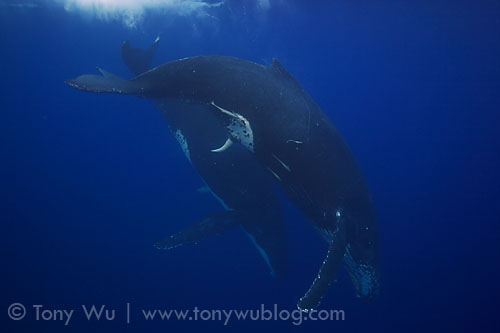
No doubt about what's on his mind
People
It was an unusual week for me. After so many seasons here, I have somewhat of a fixed pattern of doing things. This past week+ broke the pattern (different boat, different procedures, different focus out on the water, new gadgets, new software to wrangle), which made things difficult in a way, but also highly rewarding.
Besides the whale-related stuff I described above, I spent time with terrific people, who may not have participated in my usual gung-ho whale photography trips.
Without exception, they were terrific(!), and I am delighted to be able to call them friends (not sure if the feeling is mutual of course).
One of the best discoveries from my first few days in Vava'u was the new Chinese restaurant, Golden Lily. One of the most difficult things for me about extended travel is being away from Asian food. I'm perfectly adaptable and can get along just about anywhere, but I can't help but crave for Asian food every once in a while. This place solves the problem!
The food is…let's just say awesome. Richard and Song Ye, my two guests from China, and two of their friends who were also in Vava'u, approved of the food, so I suspect I'll find myself here a lot:

Final feast for the inaugural acoustics research trip
More people start arriving today, and we hit the water again tomorrow. Can't wait to see what the whales choose to share next!
Cast of characters for my inaugural Humpback Acoustics Adventure:
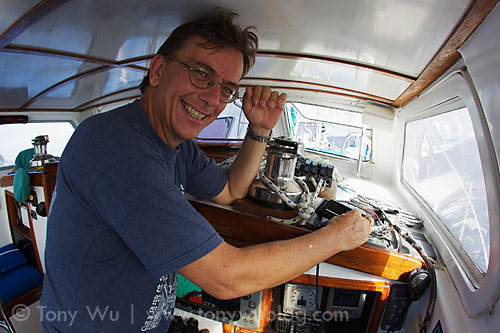
John fiddling with gadgets
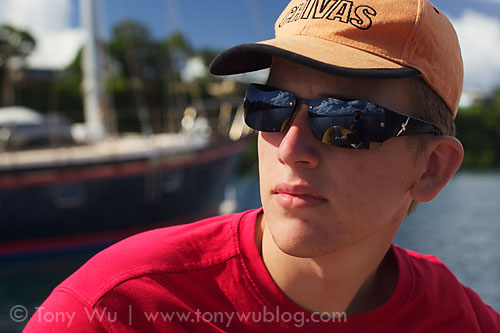
Casper giving me a ride to the dock
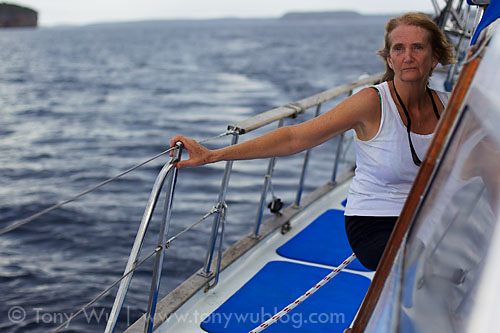
Christy surveying the seas ahead

Ali looking cool on the aft deck of Jocara

Frederick imitating The Thinker
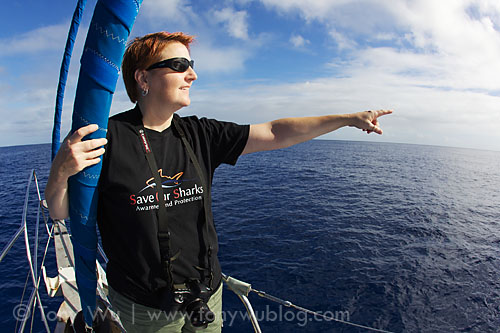
Gina, not posing at all. Nope. Not posing.

Richard, Song Ye (aka Mermaid) and their two friends from Beijing
Related Posts
Humpback Whales in Tonga 2010 | Part 1
Humpback Whales in Tonga 2010 | Part 3
Humpback Whales in Tonga 2010 | Part 4
Humpback Whales in Tonga 2010 | Part 5
Humpback Whales in Tonga 2010 | Part 6
Humpback Whales in Tonga 2010 | Part 7
Humpback Whales in Tonga 2010 | Part 8